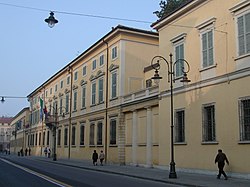
Province of Reggio Emilia
Province of Italy / From Wikipedia, the free encyclopedia
Dear Wikiwand AI, let's keep it short by simply answering these key questions:
Can you list the top facts and stats about Province of Reggio Emilia?
Summarize this article for a 10 year old
The province of Reggio Emilia (Italian: provincia di Reggio nell'Emilia; Emilian: pruvînsa ed Rèz) is a province in the Emilia-Romagna region of Italy. The capital city, which is the most densely populated comune (municipality) in the province, is Reggio Emilia.
Province of Reggio Emilia | |
|---|---|
 Ducal Palace, the provincial seat | |
 Map highlighting the location of the province of Reggio Emilia in Italy | |
| Country | |
| Region | Emilia-Romagna |
| Capital(s) | Reggio Emilia |
| Comuni | 42 |
| Government | |
| • President | Giorgio Zanni (PD) |
| Area | |
| • Total | 2,291.26 km2 (884.66 sq mi) |
| Population (30 June 2023) | |
| • Total | 525,366 |
| • Density | 230/km2 (590/sq mi) |
| GDP | |
| • Total | €17.961 billion (2015) |
| • Per capita | €33,694 (2015) |
| Time zone | UTC+1 (CET) |
| • Summer (DST) | UTC+2 (CEST) |
| Postal code | 42010-42025, 42028, 42030-42035, 42037, 42039-42049, 42121-42124 |
| Telephone prefix | 0522, 0536 |
| Vehicle registration | RE |
| ISTAT | 035 |
It has an area of around 2,292 square kilometres (885 sq mi) and, As of June 2023[update], has a population of 525,366. There are 42 comuni in the province.[2] Rolo, the smallest comune in the province by area, is the comune farthest to the East. Ventasso is the comune farthest to the West. The border towns of the province are Ventasso, which is the smallest comune by population, to the south and Luzzara in the north. Luzzara is the second largest comune in Emilia-Romagna and has the highest number of foreign nationals in the region.[2]
The province is home to the historical Canossa Castle, property of the countess Matilde; it is where the Walk to Canossa of Henry IV occurred. Representatives of the free municipalities of Reggio, Modena, Bologna and Ferrara met in Reggio Emilia's Sala del Tricolore in 1797 to proclaim the Repubblica Cispadana, adopting the three colour green-white-red flag to represent their newly formed Republic; it was later adopted in 1848 as the national flag.[3]

